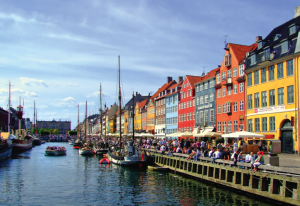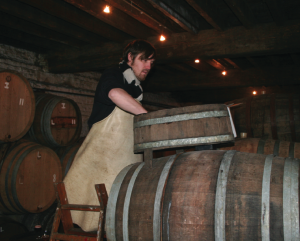This Scandinavian city is cultivating an enthusiastic crop of brewers and fans that are bringing beer into a new era.
By Brian Yaeger
Charlie Papazian, the president of the Brewers Association and author of “The Complete Joy of Homebrewing,” famously conducts the Beer Town USA online poll each year to take stock of which city has the greatest beer scene—brewers, publicans, devoted fans and all. In 2009, 2010 and again in 2011, heads spun when the winner wasn’t Portland, San Diego or Philadelphia but Asheville, N.C. In turn, the spotlight now shines brightly on the western Cackalackee hamlet with its nine-and-growing breweries. But what if the poll were to be expanded worldwide?
People might vote for Munich or London, or probably Brussels. But there’s a pretty strong argument that they’d all be dead wrong. The answer may very well be Copenhagen. No longer are the Danish merely famous for their, uh, Danishes; take, for instance, that Denmark boasts 10 Michelin-starred restaurants including the two-star Noma, named best restaurant in the world back-to-back by Restaurant magazine. And the “New Nordic” culinary wave—filled with delicacies like sustainable Limfjords oysters with house-fermented gooseberries—is cropping up at trendy spots like Manhattan’s Aquavit. But the Danish brewery boom started even before all of that, and the craft beer movement is gaining traction throughout Scandinavia.
Mikkel Borg Bjergsø—known to beer geeks the world over—is the mind behind the Mikkeller brand, and has a hand in making some of the most innovative and delicious beers on the planet, like last year’s 19-beer Single Hop series of IPAs. He’s a gypsy brewer, which ultimately means there is no “there” there; he simply takes over another brewery’s facility to create his own brand of beer. In Mikkel’s case, that means brewing chiefly at De Proef in Belgium, but sometimes Norway’s Nøgne Ø, or conveniently at Amager right in Copenhagen.
Also gaining stardom among the same beer-minded demographic is his identical twin, Jeppe Jarnit-Bjergsø, who recently joined the band of gypsy brewers by launching Evil Twin. He concocts mesmerizing beers like his Belgian strong ale brewed with muscovado sugar he calls Monk Suffers Serious Sugar Rush On Barbados. Unsurprisingly, the brothers have some good-natured competition, dating back at least to the time when Jeppe says they were ranked the top two mid-distance runners in all of Denmark. (Perhaps that explains why they currently each sport Steve Prefontaine-esque ’stashes.) But a lack of competitive spirit breeds complacency, which is precisely why the Bjergsø twins are crucial to the Danish brewing industry.
*
At the end of the 20th century, Denmark had around a dozen breweries to its name, most conspicuously Carlsberg, one of the world’s largest brewers of industrial lager. A decade into the 21st century, the nation boasted almost 150 breweries. That number is down a bit now, just like the loads of American micros that flatlined in the ’90s, shortly after the first wave of microbreweries cropped up. Even still, beer is thriving: The approximate ratio of the U.S. population to the number of breweries is 170,000 to 1. In Denmark, population 5.5 million, it’s closer to 50,000 to 1.
Several factors contributed to the wellspring. The premier Danish brewpub, Bryggeriet Apollo, opened in 1990, and the first microbrewery to really make a splash, Brøckhouse, opened in 1995. This is when Danes got their first taste of a locally brewed IPA. Though the brewery filed for bankruptcy in 2009, the deed had been done.
Danske Ølentusiaster, which translates to Danish Beer Enthusiasts, materialized in 1998 and acts as a sort of Danish counterpart to the U.K.’s CAMRA (Campaign for Real Ale), a bona fide consumer advocacy group for beer drinkers. A flood of well-crafted imports gave Danes a taste of the good stuff. As a result, a significant number of them tried to get their gullets on every new beer they could find. Rather than jotting down their tasting notes on napkins or in journals, they turned to RateBeer.com to record their reviews.
One such reviewer was Jeppe Jarnit-Bjergsø, who joined the site in 2003. Jeppe said he reviewed some 1,200 beers in a year, making him the fourth most prolific “RateBeerian” in 2005. Today, he’s rapidly falling out of the top 300 users. The top four users now have more than 20,000 reviews to their name. They all hail from Denmark. At the top is January Bolvig with more than 23,000 reviews posted under his RateBeer name Fonefan, and Bolvig says such serious “ticking”—checking off every beer obtainable to elongate their Tried-It list and decimate their Haven’t-Tasted-Yet list—takes commitment. “I normally host a tasting every month where we start tasting beers Friday night. We do the same thing again on Saturday. We have a barbecue, loads of fun and many, many beers,” he says of the sessions that can include more than 200 bottles. “Then, after breakfast on Sunday, everyone goes home.”
Recognizing this small but mighty group, the Bjergsøs put enterprising plans into action. Jeppe built Ølbutikken, a bottle shop in the center of Copenhagen that is recognized as what they humbly describe as “probably the most” venerable specialty shop in the world. While beer geeks in Munster, Ind., queue up overnight to score some Three Floyds Brewing Dark Lord—the mythic imperial stout with a festival celebrating its lone release day and is so rare, some attendees leave empty-handed—Danes can find a bottle or two sitting unassumingly on Ølbutikken’s shelves. (Jeppe also created Drikkeriget—an import company that translates to Drinking Kingdom—that’s responsible for bringing many elite American beers to Denmark and throughout Europe.) Even more scarce is Cantillon Blåbær, the blueberry lambic that Jeppe helps brew in Brussels; Ølbutikken is the exclusive retailer.
Mikkel isn’t standing in the shadow of his brother; he is one of the world’s most prolific brewers, and renown for tinkering with single ingredients to see how it will alter a recipe. He created a 24-beer series of single-hop IPAs, and a similar series of ales fermented by various yeast strains. He also crafted the Black Hole series, which starts with a batch of coffee-, vanilla- and honey-infused Russian Imperial Stout, which is divided and aged in several unusual barrels, including ones that once held tequila and white wine, to see how different wood changes the flavor.
*
Had early American craft brewers merely re-created traditional styles such as English bitters, German lagers and even Belgian abbey ales, domestic enthusiasm may have waned. But they turned those traditions into springboards for resurrecting extinct styles and innovating new ones. In short order, American beer went from laughingstock to Holy Grail.
Following this American-led revolution, no one took up the mantle more than the Danish. Many are avid globetrotters. What they didn’t discover on shelves at home, they sought abroad, from around Europe and throughout America. Danish homebrewers took cues from the American brewing revolution and began launching their own breweries. Sean Hill, who recently established Hill Farmstead Brewery in northeast Vermont, spent a few years living and brewing in Denmark. “There, it’s more about people influencing the place than the place influencing the people. Danes are more about traveling. Actually, that’s very Viking, isn’t it?” Only, instead of pillaging, these modern Vikings take inspiration.
Anders Kissmeyer left his post as Carlsberg’s brewmaster to launch his own brewery and pub, Nørrebro Bryghus. “Many of the Danish craft beers are highly inspired by the U.S. beers—hoppy ales, imperial this and that, barrel-aged beers, etc.” But if they were merely clones, Danish beers like Nørrebro’s wouldn’t have found an audience at home or among Americans seeking something worthy of import prices. Kissmeyer suggests what that Danish je ne sais quoi is. “I would claim that our Scandinavian colleagues do have a different feel to them: something rather European in terms of focus on subtlety, balance and elegance as opposed to just impact.”
Massachusetts-based Shelton Bros.—the brothers being Daniel, William and Joel—would agree. They are among the importers now tapping Denmark for inquisitive Americans, and currently boast eight Danish brewing companies in their portfolio. It started with Ølfabrikken, co-created by a brewer named Christian Skovdal Anderson in late 2004. While Ølfabrikken has withered, Anderson has joined the ranks of Copenhagen’s gypsy brewers, establishing Beer Here. And joining him is Kissmeyer, who launched side-project gypsy brewery/consultancy Kissmeyer Brewing. Not surprisingly, both Beer Here and Kissmeyer are imported by Shelton Bros., under the eye of Matt Dinges, who’s responsible for procuring beer from Scandinavian breweries. He says it all started when “Dan and Will were in Denmark and heard there was some stuff going on around the beer scene,” which is how they came across Mikkel early on.
Today, Mikkel serves as a sort of scout for his brewing compatriots. He tipped Shelton Bros. off to Amager Bryghus, started by homebrewers Morten Valentin Lundsbak and Jacob Storm in 2007. Embracing the flavors of Denmark, Amager makes a rye porter that tastes like Danish rugbrød (that is to Denmark what sourdough is to San Francisco).
Others are also digging into Nordic roots, literally and figuratively. Per Kølster is the brewer behind farm-based Fuglebjerggaard, who does everything from growing his own barley to keeping bees and using the honey to inoculate his brews. And Dansk Mjød makes its Old Danish Braggot in collaboration with Ørbæk Bryggeri, re-creating an 18th-century Danish beer blended with mead and ginger that would taste familiar to the real Vikings.
Interestingly, the Bjergsøs both indicate that it’s their neighbors in Sweden who are driving their respective European sales. But Jeppe points out that even in light of some fantastic breweries in Norway and Sweden, Denmark still leads Scandinavia in brewing.
Mikkel opened the sparse, sleek Mikkeller BAR—Copenhagen’s premier beer bar, where only half of the 20 taps are Mikkeller’s—saying, “It is for everyone: the novice that comes to learn and the pro who comes to sample the rarest of rare beers.” His brother thinks it will help continue their momentum, saying, “Some of the new guys will be inspired by him.” But in the meantime, they’re both eyeing American shores. Mikkeller’s Invasion IPA is brewed at Drake’s Brewing in the San Francisco Bay Area. A couple batches of Evil Twin including Biscotti Break Porter were brewed at Westbrook Brewing in Charleston, S.C. Perhaps they’ve already outgrown their small country. They’ve already taken a page out of our brewing playbook, so let the Danish Invasion begin. •
DRINK UP: Mikkeller’s Copenhagen Beer Celebration (May 11-12) is poised to be one of the preeminent beer happenings on the planet. Some 250 beers, many of them world debuts, will be poured by more than two dozen venerable breweries from nearly a dozen countries such as Mikkeller protégés To Øl, Yankees Three Floyds and Green Flash, New Zealand’s 8 Wired, and Kiuchi from Japan. Celebrants will drink communally while feasting on meals prepared by some of the best chefs in Denmark. “Our intention is to make a small, cozy festival where the main priority is quality,” says Mikkel Borg Bjergsø, principal organizer of the event that promptly sold through a mere thousand tickets available each day. Beg anyone you know for tickets, or follow the fun at CopenhagenBeerCelebration.com.












